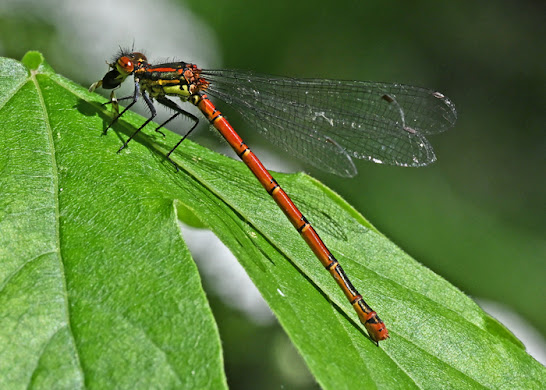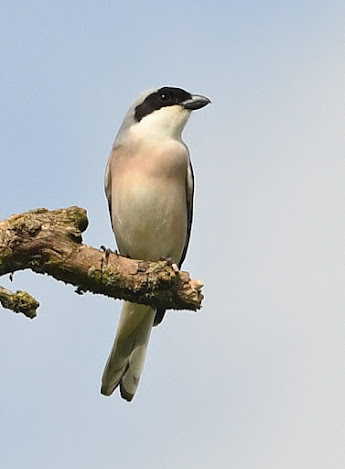May started with very variable weather: a couple of decent days, followed by a deluge on the 3rd which took the year's rainfall total in my garden to over one foot (305mm), easily the wettest start to any year whilst I've been keeping weather records. Further rain followed on the 6th, but after that things settled down as high pressure moved in and (for once) this wasn't accompanied by cold, northerly winds.
Swifts were back over Royston town centre from the 8th, a couple of days earlier than last year, and a lone House Martin was spotted near Hatchpen Farm on the same date. Good numbers of Lesser Whitethroats were singing on my Local Patch, alongside the Blackcaps, Chiffchaffs and Whitethroats. However, these four species are now all that is left of our breeding warblers. Willow Warblers were sporadically recorded in the previous few springs, although they probably didn't breed, but this spring none were recorded at all on my walks. Sadly, but not surprisingly, no Lapwings were recorded on my Local Patch this spring either. A solitary, lonely individual stayed around for a week or so last spring, but so far I have yet to record any at all this year. Lapwings have certainly been lost as a breeding species near Royston, and I suspect that within a few years they will no longer nest in Hertfordshire. As usual, loss of habitat is a leading cause, coupled with predation of the few remaining chicks and eggs by (usually) crows. To see and hear Lapwings displaying over their breeding fields and to hear the lovely descending cadence of a Willow Warbler's song are two of the most inspiring sights and sounds of spring. What have we left to enjoy now? How do we know that spring is here?
I spied a Common Lizard just off The Heath on the 7th. Unfortunately, it was hiding behind some grass, but I'll include its photo anyway.
Common Lizard, Royston, 7 May
The poor weather led to late emergence of some butterfly species. Large, Small and Green-veined Whites, Orange Tips and Holly Blues were widespread and I again saw a single Small Heath butterfly on Church Hill on the 7th, but there was no sign of Brown Argus or other blues early in the month. However, I did get more opportunities to use my new camera and macro lens to photograph other insect families. I found no fewer than five different species of bugs: Green Shieldbug, Hawthorn Shieldbug, Hairy Shieldbug, Crucifer Shieldbug and an uncommon Rhopalid bug with the Latin name Corizus hyoscami. Crucifer Shieldbugs are fascinating: they come with red or white spots and markings and are almost always seen as mating pairs (!), which could be red-red, red-white or white-white. To relieve the tedium of my text, here are a few images of the various bugs.
Green Shieldbug Mating Pair, Royston 30 April
Hawthorn Shieldbug, Royston, 30 April
Hairy Shieldbug, Royston, 30 April
Crucifer Shieldbug Mating Pair (Red-White), Therfield Heath, 30 April
Crucifer Shieldbug Mating Pair (White - White), Therfield Heath, 7 May
Rhopalid Bug Corizus hyoscyami, Royston, 7 May
I saw my first damselfly of the year (a female Large Red Damselfly) in my local woodland on the 5th. A large number of confusingly similar nomad (?) bees were seen and photographed locally. If I ever get round to identifying them I'll put a couple of images up. A Gooden's Nomad Bee is the only species that I have definitely identified. One insect that I definitely could identify was a huge Cockchafer, which flew into me as I was taking out some items to put in the recycling bin on the evening of the 7th. I'm not sure which of us was the most shocked!
Female Large Red Damselfly (with Prey), Royston, 7 May
I had planned for a quiet afternoon, maybe to do some housework or gardening, on the 10th but then the news came through that a Lesser Grey Shrike (a 'first' for Hertfordshire) was showing well along the Icknield Way between Hexton and Lilley, not far from the Bedfordshire border. Of course I went to see it, braving long traffic jams going through Hitchin. The bird was perching in dead trees, flying up to catch insects then returning to the same or another perch, rather like a Spotted Flycatcher. I managed one image of the bird in flight, chasing a fly, and although (sadly) it isn't completely sharp, I'll include it below, together with images of the shrike perching - what a smart bird! On the way back I stopped off at Hexton Pits, where I saw 12-15 Dingy Skippers and a Green Hairstreak butterfly.
Lesser Grey Shrike, Lilley, 10 May
Lesser Grey Shrike, Lilley, 10 May
Lesser Grey Shrike about to catch a Fly (diffuse blob top right), Lilley, 10 May
Bird watching highlights on my local patch were few and far between during the rest of May. A couple of male Yellow Wagtails were seen along the Icknield Way east of Royston on the 11th, a family of Coot (eight young), a pair of Tufted Ducks, and a pair of Little Grebes were all at Phillup's Lake on the 13th and these were joined by two families of Mallard (eight and ten young) on the 20th. Hirundines (House Martins and Swallows) were seen feeding over or near the lake on both occasions. A Spotted Flycatcher, seen in woodland close to the Therfield Road, was my first of the year - hopefully it will be joined by others, so that the presence of this increasingly rare species can continue here in future years. Finally, a probable Garden Warbler was heard at the bottom of Church Hill on the 27th. I say 'probable' because, although I caught glimpses of its silhouette, I couldn't be absolutely certain that it wasn't a Blackcap with an aberrant song.

Mallard Family, Phillup's Lake, Reed End, 20 May
My visits to Amwell nature reserve were rather more productive, particularly for wading birds. A Redshank and Little Ringed Plover were seen on the 13th, whilst a winter-plumaged Knot on the 20th was a Hertfordshire 'first' for me. A cuckoo was also seen here on the latter date, when at least two were singing.
Little Ringed Plover, Amwell NR, 13 May
I visited Therfield Heath (in particular, Church Hill) every 3-4 days throughout the month, looking for butterflies and moths, in particular Brown Argus, Common and Adonis Blue butterflies. However, only a handful of Small Heath butterflies and lots of Silver Y moths could be found away from the woodland until, finally on the 20th, four Brown Argus and a single Common Blue butterfly were seen on Church Hill. I had to wait until the 25th to see my first (male) Adonis Blue, also during a brief visit to Church Hill. The following day a male Adonis Blue was seen at the other end of The Heath, on the Old Rifle Range. The late emergence and low numbers of these butterflies in May presumably reflects the very wet spring (and winter) weather and the complete lack of any long, dry, settled periods of weather in the spring.

Comparison of the outer Wing Markings of (left) male Common Blue (Church Hill; 20 May) and (right) male Adonis Blue (Old Rifle Range; 26 May). Note the clear wing border of the Common Blue and the brownish (not grey) coloration of the hind wing of the Adonis Blue.
Whilst animals have been having a tough time in the wet weather, the same cannot be true for wild plants. There has been just enough sunshine and warm weather to promote extensive growth, particularly of grasses and wild flowers - I am thinking of getting a machete to cut a passageway through plants on some of the narrower tracks on my local patch. Orchids, in particular, seem to be benefiting. There was a good showing of White Helleborines in Fox Covert in May, whilst I saw the first Bee Orchids unusually early, on Church Hill, on 20 May. Fragrant Orchids also started to appear towards the end of May - no thanks to me, as I almost trod on them before being 'alerted' (i.e. told off) by another photographer....
Bee Orchid, Church Hill, 20 May















No comments:
Post a Comment